This post may contain affiliate links. Please read our disclosure policy.
With its super crisp shell and soft marshmallow center, my Pavlova recipe is the ultimate treat. Stack pavlova layers with whipping cream and mixed berries on top for a delicious cake that is perfect for every occasion.
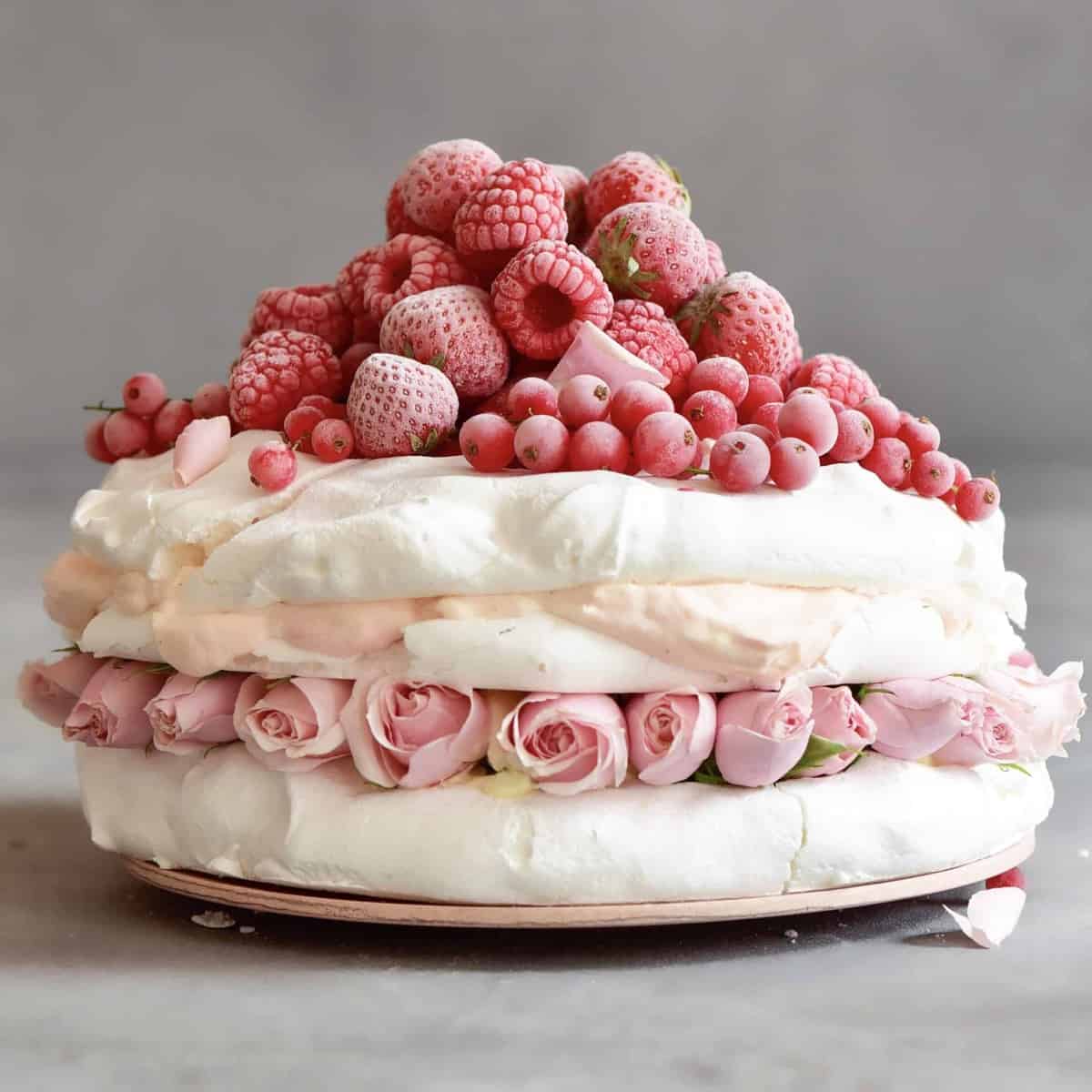
Whether you want to impress guests on a special occasion or just wow the family, this dessert is sure to delight all those who try it! Plus, the crisp outer shell and soft, chewy inner center of the Pavlova is one of my utmost guilty pleasures.
Table of contents
What is Pavlova?
Pavlova is a dessert named after a Russian ballerina. Its light texture is said to be inspired by her tutu. While very similar to a meringue in that it is an egg white and sugar-based dessert whipped up into a light, fluffy, melt-in-the-mouth dessert, there is a difference between the two. Unlike traditional meringue, which is hard and dry throughout, Pavlova is meant to have a hard outer shell, with a soft marshmallow-like interior.
Making this dessert can be a bit tricky, but the end result is absolutely worth it! Plus, you can make it even better by adding some whipped cream and fruit on top to hide any “flaws.”
Ingredients
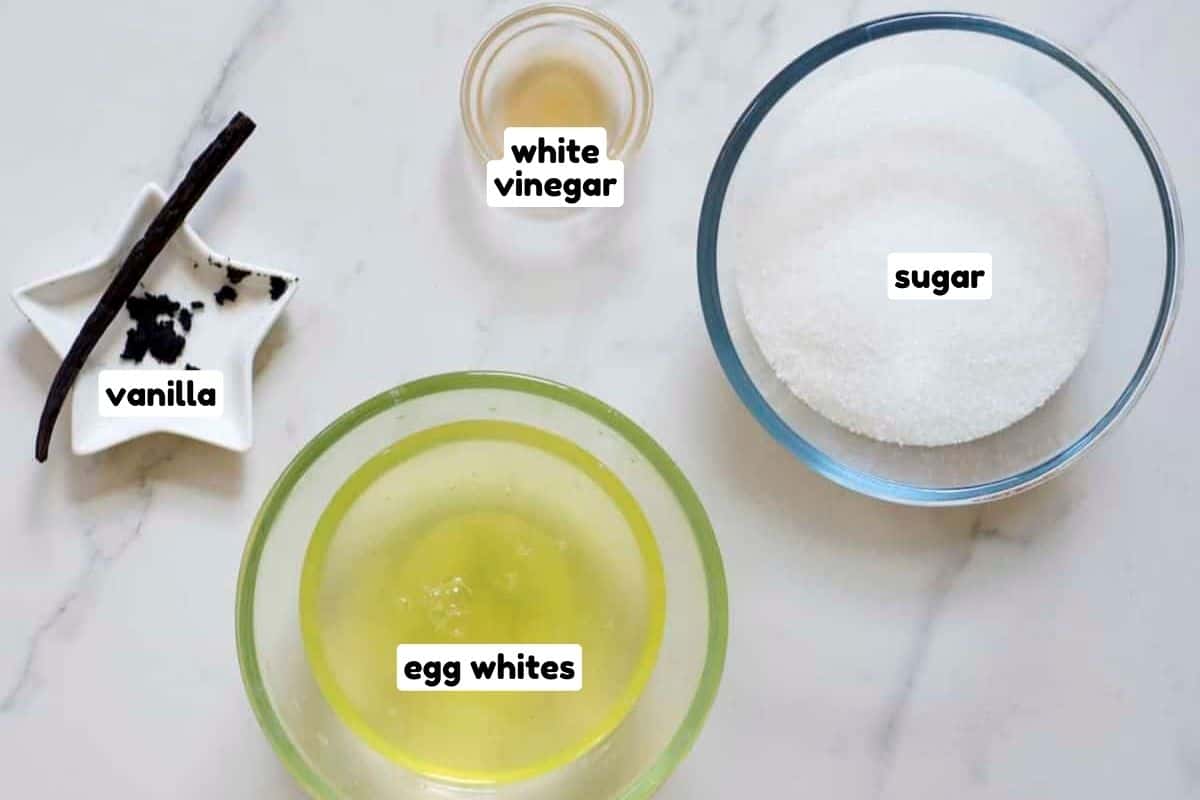
- Sugar: Castor sugar will take the least amount of time to whip into the egg-white mixture. You can pulse granulated sugar into a finer sugar. I originally used granulated sugar for this recipe (as pictured), but now I always use caster sugar.
- Egg Whites: Make sure to use room temperature eggs, as cold ones won’t whip as easily.
- White Wine Vinegar: An acid such as vinegar or lemon juice helps to stabilize the egg mixture as it foams.
- Optional: Cornstarch/Cornflour helps the center retain its melt-in-the-mouth marshmallowy texture. It also helps stabilize the egg whites during baking and prevent weeping, especially if you live in humid climates.
- Heavy Whipping Cream: Used to fill between the Pavlova layers.
- Vanilla Extract: To flavor the whipping cream.
- Natural Berry Powder (optional): Mix with whipping cream to achieve a pink hue.
- Frozen Mixed Berries: For garnishing the top.
- Edible Roses: For decoration.
How to make Pavlova
Start by separating the egg whites from the egg yolk (you can use the egg yolks for this Caramel Ice Cream).
Prepare Pavlova Mixture: Whip the egg whites in a stand mixer on medium speed (4-5) or a lower speed with a hand mixer until they reach soft peaks. Gradually add sugar, one tablespoon at a time, waiting 20-30 seconds between each addition to allow the sugar to whisk and dissolve. Continue whipping until stiff peaks form, and the mixture is thick and glossy with the sugar fully dissolved.
To check if the sugar is fully dissolved, take a small amount of the Pavlova mixture and feel it between your fingers for any granules. If there are none, the mixture is ready. Carefully mix in the vinegar, ensuring not to overwhip or deflate the mixture.
If wanting to include cornstarch, then simply combine it with the vinegar into a slurry before mixing in.
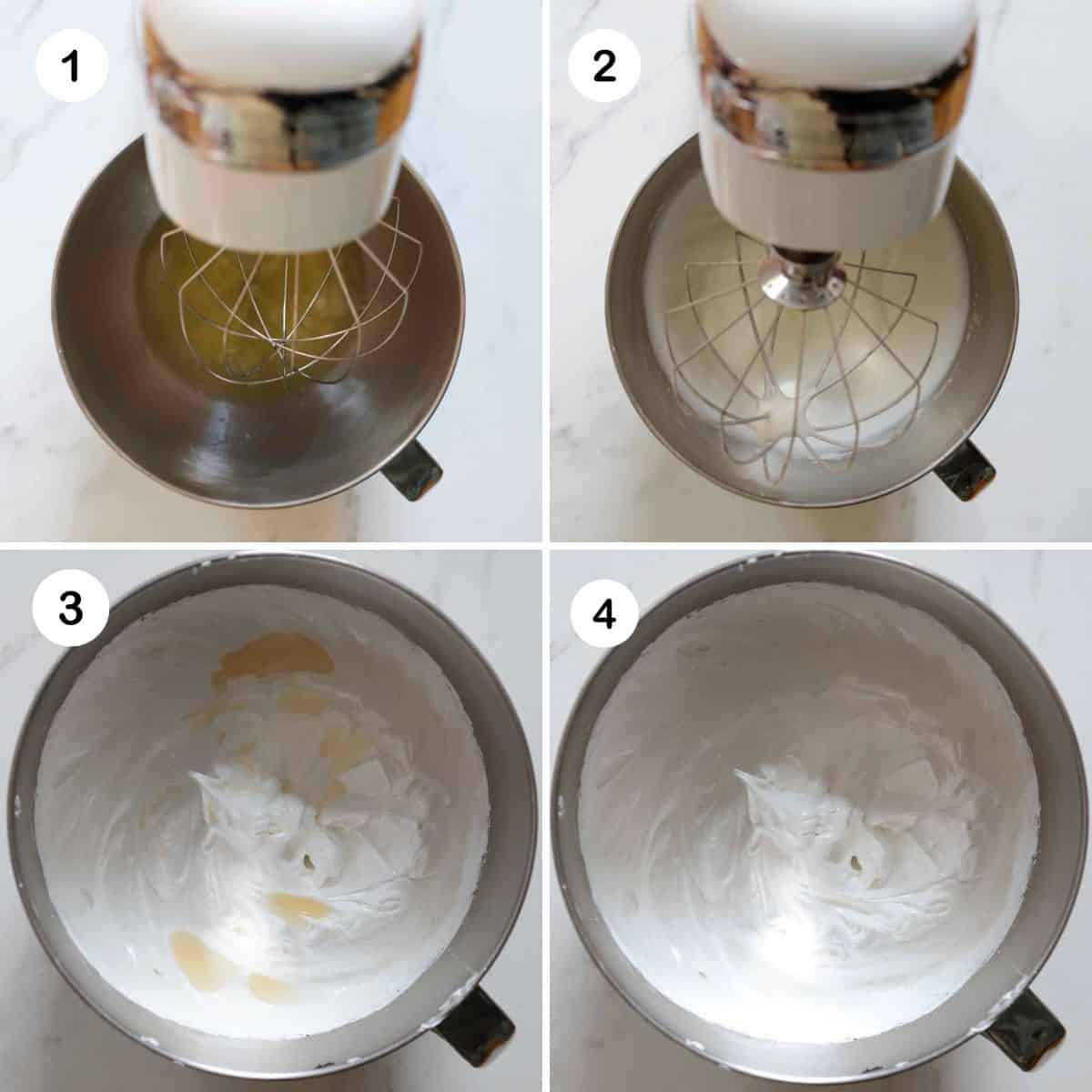
Shape Pavlova: First, preheat the oven to 275ºF/140°C. Then, depending on how thick you want the pavlova to be, prepare two or three baking sheets with parchment paper. Line your baking sheets with parchment paper and use a plate to trace circles for consistent layer sizes.
Divide the mixture among the sheets, spooning it into the center of each traced circle, then gently spread it out evenly with a spatula.
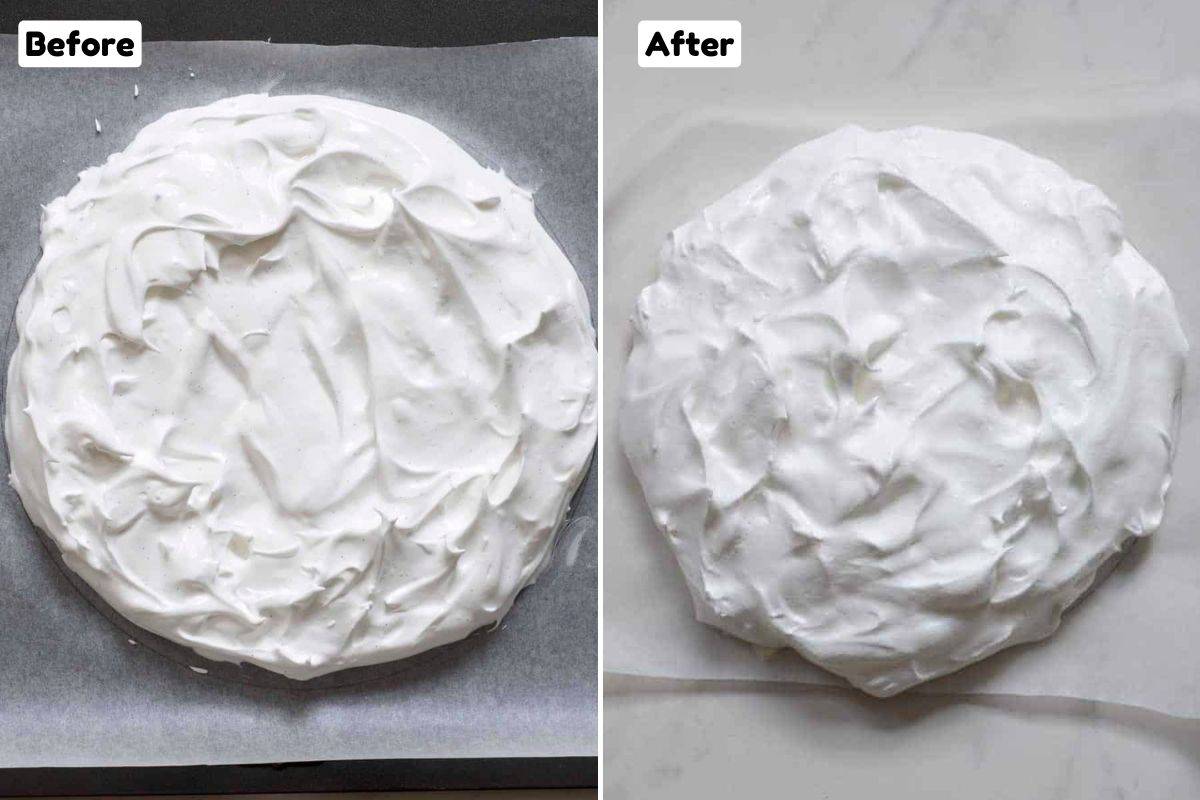
Bake: Bake the Pavlova at 275ºF/140°C until the exterior is crisp and no longer sticky and the surface loses its shine. This usually takes between 70-120 minutes depending on the thickness of your layers and the specifics of your oven.
Cool: Once baked, turn off the oven and let the Pavlova cool completely inside the oven (at least two hours) to help it stabilize and prevent cracking.
Whip Cream: Whip the heavy cream with vanilla bean extract and berry powder (if using) just before serving.
Assemble: Layer the Pavlova by starting with edible roses, followed by whipped cream, and finishing with mixed berries.

Troubleshooting common Pavlova fails
Here are my top tips, tricks, and general notes I’ve collected over the years.
- Do not overbeat the egg whites, as this can lead to deflated, cracked, and even “weeping” Pavlovas. The mixture needs to look thick and glossy, with the sugar fully dissolved. Make sure the egg whites are pure—or else this just won’t whip properly.
- All of your equipment and utensils need to be perfectly dry. Moisture will affect its success.
- Add the sugar to the egg whites slowly, at a slow/medium speed (4-5 on a stand mixer). One tablespoon at a time is more than enough for the slow dissolve that makes for a perfectly integrated sugar/egg white mixture.
- Pavlova is sensitive to humidity. Avoid making it on very humid days, as this can cause it to weep, collapse, or become soggy quickly.
- Make sure that the dessert cools down gradually. It’s best to leave it in the oven until it is completely cooled (at least 2 hours) and don’t be tempted to open the oven during the baking time. Any sudden changes in temperature can lead to cracked, collapsed shells and less of a gooey interior.
- The key to perfecting Pavlova lies in patience. Whisk at low to medium speeds (4-5 on a stand mixer) for stability. Cook it slowly at low temperatures to achieve a crispy shell with a soft marshmallow center.
- Baking times can vary based on your oven and altitude. If the center remains soft, try increasing the oven temperature by 50°F/10°C or extending the baking time at the current lower temperature.
More sweet recipes you’ll love
If you try this recipe, let me know how it goes in the comments below. I’d appreciate a recipe card rating and would love to see your recipe recreations – tag me on Instagram @Alphafoodie!
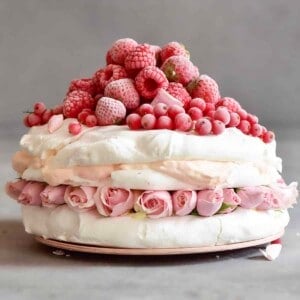
Best Pavlova Recipe
Ingredients
- 6 egg whites
- 1 ½ cups caster sugar
- 1 tsp white wine vinegar or 1/2 tsp cream of tartar
- 1 Tbsp cornstarch optional – mix into a slurry with the vinegar before adding to the egg white mixture
- 12-16 oz heavy whipping cream quantity depending on how much cream you like (chilled overnight in fridge)
- 1-2 tsp vanilla
- 1 tbsp strawberry or berry powder optional – for strawberry whipped cream
- mixed berries to decorate
- Edible Roses to decorate
Instructions
- Separate the egg whites from the yolks and bring them to room temperature.
- Whip the egg whites until soft peaks form. Gradually add the granulated sugar, ensuring each addition fully dissolves before adding more. Check for sugar dissolution by rubbing a small amount of the mixture between your fingers.
- Fold in the white wine vinegar. Optionally, combine cornstarch with vinegar into a slurry before mixing in.
- Preheat the oven to 275°F (140°C).
- Line baking sheets with parchment paper and trace circles for consistent layer sizes. Spoon the Pavlova mixture into the center of each traced circle and spread evenly.
- Bake the Pavlova at 275°F (140°C) until the exterior is crisp and dry, typically 70-120 minutes.
- Turn off the oven and let the Pavlova cool completely inside for at least two hours.
- In a separate mixing bowl, whip the heavy cream with vanilla bean extract and berry powder (if using).
- Transfer the cooled Pavlova layers to a serving plate. Layer with whipped cream and berries.
Notes
Nutrition
Nutrition information is automatically calculated, so should only be used as an approximation.


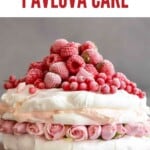

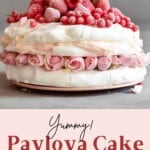


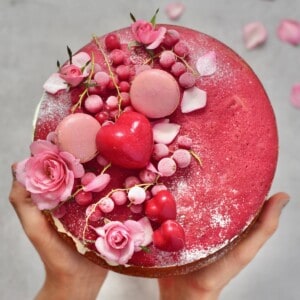









can you use already separated egg whites you can buy in the store?
Hi,
Yes, you can use store-bought egg whites to make this pavlova cake.
Learn a lot of ur instructions,. Amazing recipe. Thank you, definitely will share my friends
Thank you so much for your comment, Finnie. Glad you liked the recipe!
When you say “coconut cream”, do you mean cream of coconut like the kind you use in making pina coladas? Or do you mean the canned “coconut milk”? Cause there’s a huge difference between the cream of coconut and coconut milk
Hi Dee,
Yes, I meant cream of coconut. I guess it all depends on where you live, generally, you can find coconut cream as well as coconut milk in cans. 🙂
Gorgeous! How do you get this lovely frosted ombré effect on the fruit !?
Thank you so much, Aimee.
The fruit was frozen before I decorated the cake. Then, it gets this lovely frosted effect. Unfortunately, it doesn’t last long. 🙂
Oh my god! I can’t believe i didn’t check ur blog before! I like how you add vinegar, i always had trouble with the smell of meringue! I will have to use vinegar from now on!